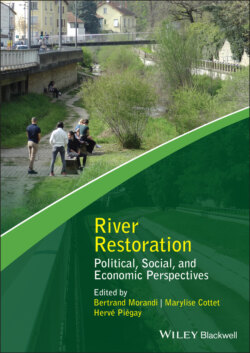Читать книгу River Restoration - Группа авторов - Страница 15
1.1.2 An evolution in the positioning of societal issues in debates on river restoration
ОглавлениеSocietal1 stakes have always structured thinking in the field of restoration. Back in the 1990s, Cairns (1995, p. 9) wrote that “ecological restoration must involve ecosocietal restoration. This is the process of reexamining human society’s relationship with natural systems so that repair and destruction can be balanced and, perhaps, restoration practices ultimately exceed destruction practices.” This thinking is part of a more general movement questioning the relationship between human and nature as it has been encompassed in modern Western thought. This questioning, which has permeated society since the 1970s, is sociocultural, anthropological, and philosophical (Gobster and Hull 2000). It is sometimes championed by natural science researchers who advocate a new ethics of nature (e.g. Jordan 2000; Clewell and Aronson 2013). These ethics are based on the recognition of nature as having an intrinsic value as much as they are based on observations of the degradation of this value by human societies. They are formed at the point of convergence between conservationist movements and scientific advances in the natural sciences. Human activities are characterized by the natural sciences, often in terms of pressures; it is a time of guilt. The ultimate goal of restoration projects is to return rivers to the good (pristine) state they were in before degradation by human societies.
Very quickly, the original idea of the river’s return to a past state, what some authors have called the myth of the return to Eden (e.g. Dufour and Piégay 2009), was strongly criticized for reasons mainly related to scientific uncertainties and technical feasibility, but also to ethical positions. Restoration is certainly based on a new attitude toward rivers, but it must also deal with reality, including the social and economic reality of its implementation. The conceptualization of the Anthropocene is part of this evolution (Crutzen and Stoermer 2000). Studies highlight the importance of both biophysical and societal contexts in the implementation of actions. It is a time for pragmatism; leaders of restoration projects seek to do the best that they can ecologically within a given context. This realization is accompanied by a discussion of the concept of restoration and an evolution of its definitions (see Box 1.1). As Wohl et al. (2005, p. 2) point out: “because both technical and social constraints often preclude ‘full’ restoration of ecosystem structure and function, rehabilitation is sometimes distinguished from restoration.” The concept of rehabilitation often carries the idea of a relaxation of the restoration objectives and a redefinition of the references used to define these objectives (Dufour and Piégay 2009). What is being restored? But above all, why is it being restored? Restoration, which until now was guided by the intrinsic value of the river, embodied by concepts such as ecological integrity, is opening up to more instrumental visions.
